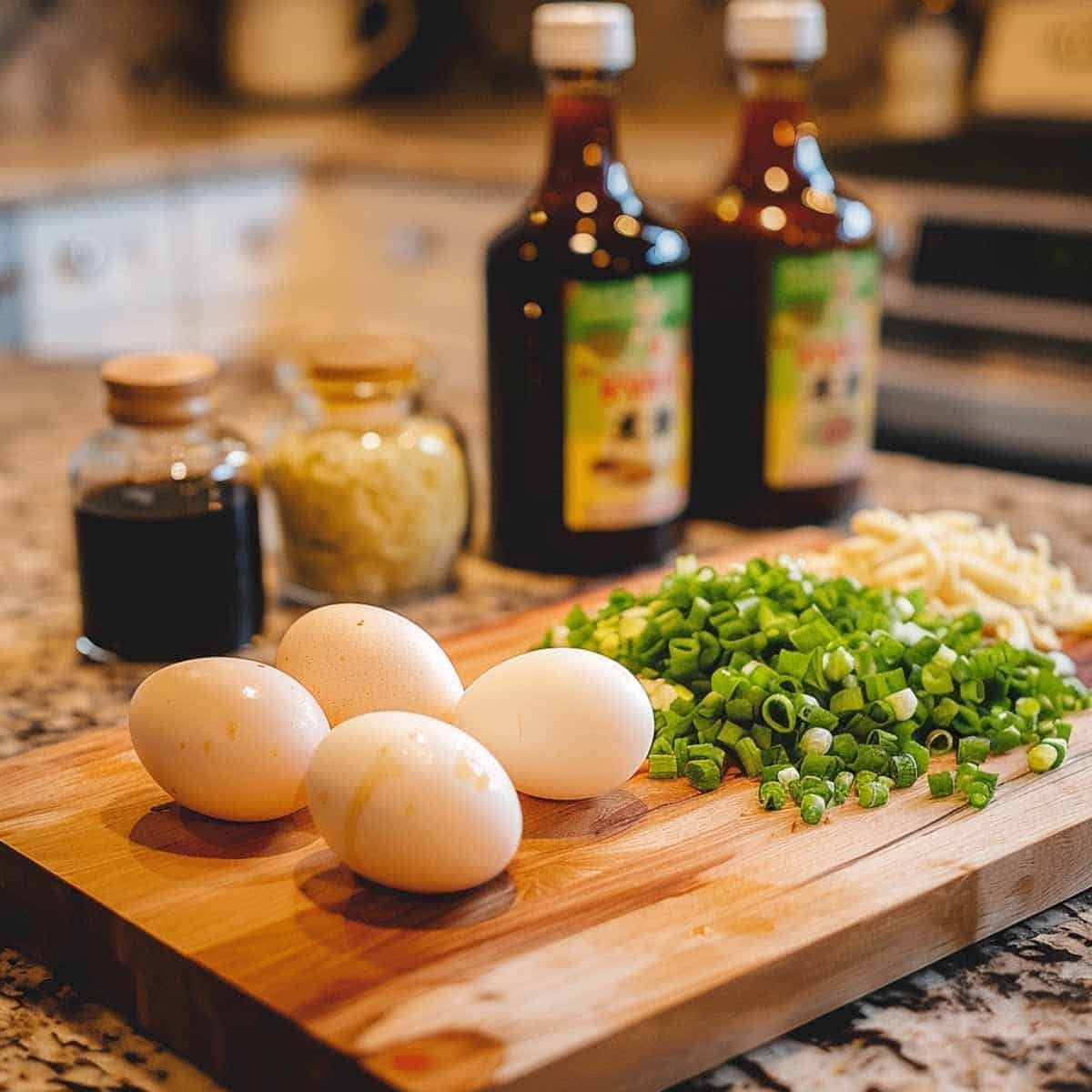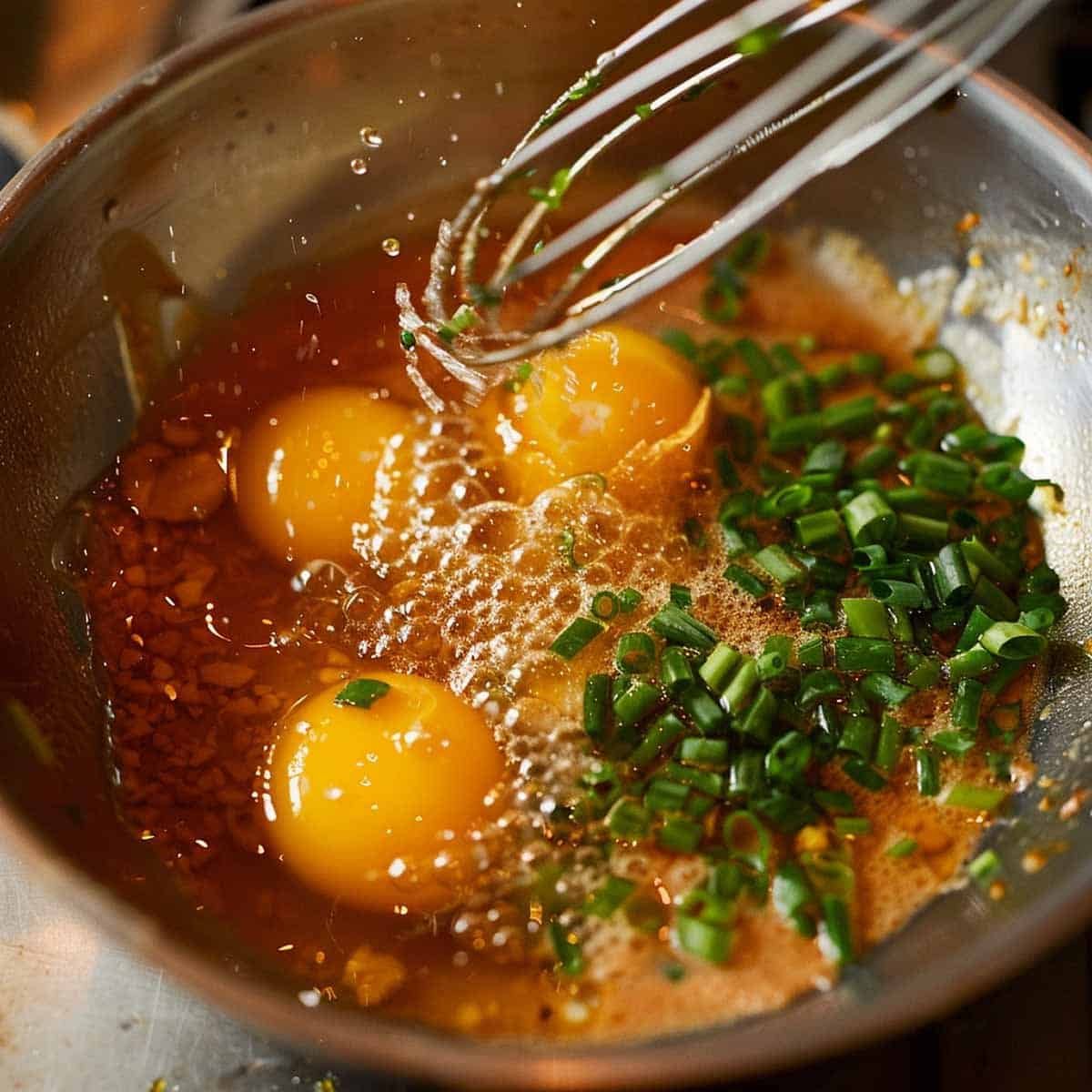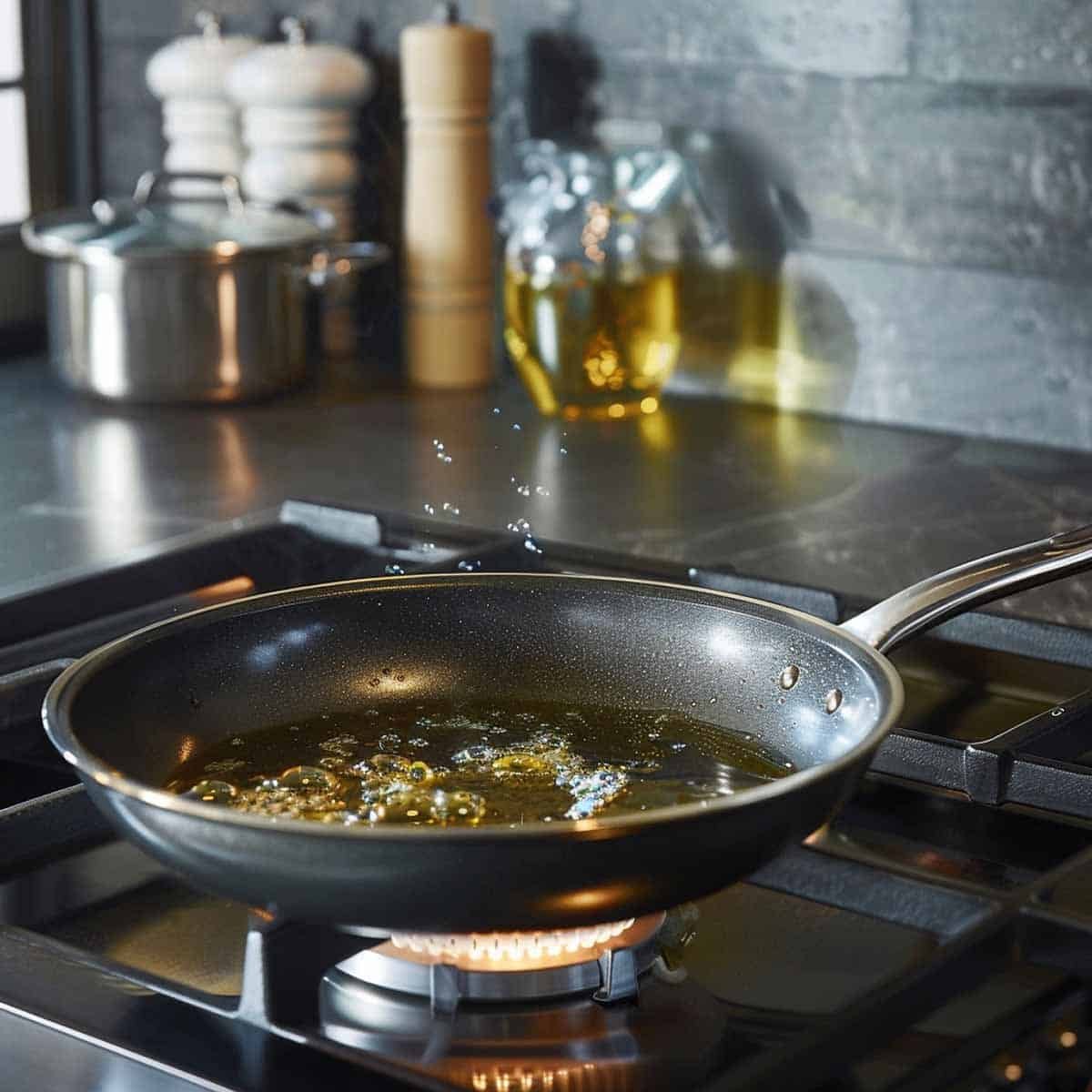Envision a delectable dish that can be whipped up in no time, brimming with tantalizing flavors and offering a delightful crunch with every bite. Thai Omelet (Kai Jiao) encompasses all of these qualities and more! This cherished street food classic is a testament to the wondrous results that can emerge from humble, uncomplicated ingredients. Its crisp outer layer and tender, flavorful interior are the perfect culinary delight for any time of the day. Continue reading to uncover the intricacies behind crafting the perfect Thai Omelet in the comfort of your own home.

Background and Influence of Thai Omelet (Kai Jiao)
The Thai omelet, known as Kai Jiao (ไข่เจียว), is a Thai cuisine cherished for its simplicity, versatility, and delicious flavor. Made primarily from eggs seasoned with fish sauce and sometimes soy sauce or oyster sauce, Kai Jiao is fried quickly in hot oil to achieve a fluffy texture with crispy edges, distinguishing it from Western-style omelets.
This dish holds cultural significance as a common comfort food found throughout Thailand. It is enjoyed both in homes and at street food stalls, often served with rice and a spicy dipping sauce. Kai Jiao's popularity stems from its ease of preparation and its fascinating ability to be adapted into various forms. It can stand alone as a main dish, be served over rice (like Khao Jiao Kai), or be incorporated into other Thai dishes such as Pad Thai or noodle soups.
Regionally, Kai Jiao may vary slightly in preparation, with additions like minced pork, onions, or tomatoes depending on local preferences. Its influence extends beyond Thailand, resonating with the global popularity of Thai cuisine, inspiring fusion dishes and adaptations in restaurants worldwide.

Sawasdee Kha, and Hello
I hope this letter finds you well and curious about another delightful culinary adventure! Today, I want to share with you a recipe that holds a deeply personal place in my heart: Thai Omelet, or Kai Jiao as we call it in Thailand. This dish isn't just about its savory flavors and comforting textures; it's about the memories it evokes of my childhood, especially those moments when my father would whip up this quick and tasty meal.
As a child, I remember the lively atmosphere in our kitchen whenever my father decided to make Kai Jiao. The aroma of beaten eggs sizzling in the hot oil, the sound of them crisping at the edges, and the sight of golden perfection as he skillfully flipped the omelet—all of these senses combined to create an atmosphere of warmth and anticipation.
What made this dish truly special were the little touches my father added: a dash of fish sauce for depth, some chopped spring onions for freshness, and occasionally, a scattering of minced pork or shrimp for extra flavor. Each bite was a perfect balance of simplicity and taste, something that resonates deeply with me even today.
Thai Omelet isn't just a dish; it's a reminder of the joy of sharing food with loved ones, and the simplicity of creating something delicious from humble ingredients. I invite you to try making Thai Omelet (Kai Jiao) and share your memories and experiences with me in the comments below. Let's savor the joy of cooking and creating cherished moments around food together.

Welcome! I'm so glad you're here. Join me in making Thai Omelet (Kai Jiao) , together—it's going to be delicious!
Ingredients For Thai Omelet (Kai Jiao)
You'll need simple ingredients to create the perfect Thai Omelet (Kai Jiao). Eggs, fish sauce, soy sauce, white pepper, green onions, and vegetable oil combine to make this delicious dish. Each ingredient is crucial in achieving the perfect balance of flavors and textures.

Whisking Eggs Like a Pro
Whisk the Eggs: Start by cracking the eggs into a bowl. Add the fish sauce, soy sauce, and white pepper. Whisk the mixture vigorously until it's smooth and frothy. This step is crucial as it ensures the eggs are well-aerated, which helps in achieving a light and fluffy texture once cooked.

Heat the Oil
Heat a generous amount of vegetable oil in a frying pan or wok over medium-high heat. The oil should be hot enough that a small drop of the egg mixture sizzles upon contact. This high heat is key to creating the crispy edges that Kai Jiao is known for.
Pour and Cook
Pour the egg mixture into the hot oil simultaneously. The eggs will puff up immediately, forming a beautiful, crispy crust. Let the omelet cook undisturbed for 1-2 minutes until the bottom is golden brown. Carefully flip the omelet and cook the other side for another 1-2 minutes. The result should be a golden, crispy omelet with a tender interior.


From Pan to Plate: Serving Up Your Thai Omelet (Kai Jiao)
When plating the Thai Omelette, use a large, round plate. Arrange the omelet in a semi-circle or cut it into even wedges for easy serving. Garnish with green onions and cilantro. Serve with jasmine rice and sweet chili sauce on the side, and add some fresh cucumber or tomato slices to complete the dish.

Tasting Notes Thai Omelet (Kai Jiao)
Visual: Thai Omelet, or Kai Jiao, is a simple yet flavorful dish enjoyed for generations. The omelet has a golden-brown exterior that is perfectly crispy and inviting. The surface is adorned with specks of green from finely chopped herbs, offering a visually appealing contrast.
Aroma: A tantalizing aroma fills the air as you approach the dish. The eggs release a comforting scent of savory richness, accompanied by subtle hints of garlic and shallots. Fresh cilantro adds a touch of herbal freshness, enhancing the overall aromatic profile.
Taste: With the first bite, the Thai Omelet delights the palate with simplicity and a delightful interplay of flavors. The eggs are seasoned to perfection, offering a delicate balance of saltiness and umami. The addition of fish sauce provides a nuanced depth, while fresh spring onions contribute a mild oniony sweetness, creating a symphony of tastes.
Texture: The texture is a highlight of Thai Omelet, showcasing a crisp exterior that gives way to a soft and fluffy interior. Each bite offers a satisfying crunch followed by a velvety-smooth mouthfeel, creating a delightful textural contrast.
Heat: The dish boasts a subtle heat that enhances the overall experience without overwhelming. If you add chili peppers, they gently kick up the savory notes of the eggs and herbs, creating a harmonious and enjoyable level of spice.
These tasting notes capture the essence of Thai Omelet (Kai Jiao), highlighting its visual appeal, aromatic complexity, balanced flavors, satisfying texture, and subtle heat. It's a dish that embodies the comfort and simplicity of Thai cuisine, perfect for any meal of the day. Thai Omelet is a versatile dish that you can enjoy at any time, whether it's for a hearty breakfast, a light lunch, or a satisfying dinner.
Thai Omelet (Kai Jiao) : Pairing, Serving, and Storage Tips.
Pairing Suggestions and Side Dishes
Steamed Jasmine Rice: A classic accompaniment that complements the savory flavors of the omelet and helps absorb its delicious juices.
Thai Papaya Salad (Som Tum): The refreshing and tangy flavors of Som Tum provide a perfect balance to the richness of the omelet, creating a meal that is both satisfying and intriguing.
Tom Yum Soup: This spicy and sour soup, with its vibrant flavors and aromatic herbs, offers a delightful contrast to the simplicity of the omelet, making it a perfect addition to your meal.
Stir-fried Vegetables: Lightly seasoned and quickly stir-fried vegetables such as bok choy, bell peppers, and snap peas provide freshness and crunch to complement the omelet.
Fresh Thai Spring Rolls (Por Pia Tod): These light and crispy spring rolls, filled with fresh vegetables and herbs, are a refreshing accompaniment that pairs well with the savory omelet, leaving you feeling refreshed and invigorated.
Sticky Rice (Glutinous Rice): Known for its slightly chewy texture, sticky rice is a staple in Thai cuisine. Its neutral flavor allows the flavors of the omelet to stand out, providing a satisfying and traditional pairing option.
These dishes, when combined, offer a versatile array of textures and flavors that elevate the enjoyment of Thai Omelet (Kai Jiao), making it a delightful and exciting meal.
How to Serve
Serve your Thai Omelet hot, straight from the pan. Additionally, place it on a plate lined with paper towels to absorb any excess oil. Furthermore, cut the omelet into wedges and serve it alongside steamed jasmine rice. Moreover, for an extra touch, garnish with fresh cilantro and a drizzle of sweet chili sauce. Lastly, this dish is excellent for breakfast, lunch, dinner, or snacks, making it versatile for any mealtime.
Reheating Options
To reheat your Thai Omelet, use a non-stick pan over medium heat. Heat each side for about 1-2 minutes until warmed through. Place the omelet on a microwave-safe plate and heat for about 1 minute to reheat. Be careful not to overheat, as this can make the omelet rubbery.
Make-Ahead and Storage
You can prepare the egg mixture and store it in the refrigerator for up to 24 hours. When ready to cook, please whisk it before pouring it into the hot oil. You can store cooked omelets in an airtight container in the fridge for up to 3 days. Reheat as needed. Visit foodsafety.gov for more information.
Required Kitchen Equipment for Thai Omelet (Kai Jiao)
- Whisk: For blending the egg mixture.
- Large Frying Pan or Wok: To cook the omelet to perfection.
- Spatula: For flipping the omelet without breaking it.
- Mixing Bowl: For combining the ingredients.
Tips for Authenticity and Customization For Thai Omelet (Kai Jiao)
Using Authentic Ingredients
Using the right ingredients is essential to achieving an authentic Thai omelet. Firstly, fish sauce is a key component, providing the umami depth that sets this dish apart from a regular omelet. Moreover, opt for high-quality fish sauce to avoid overly salty or fishy flavors. Additionally, soy sauce adds a subtle complexity, while white pepper provides a gentle heat. Furthermore, fresh green onions bring a burst of color and freshness. Lastly, use fresh, organic eggs and high-quality vegetable oil for the best results.
Adjusting Spiciness and Flavors
Add finely chopped Thai bird chilies to the egg mixture if you prefer a spicier omelet. For a milder version, you can reduce or omit the white pepper. Adjust the fish sauce and soy sauce to suit your taste preferences – a little more for a saltier profile or less for a more delicate flavor. Feel free to experiment with additional ingredients like chopped cilantro, garlic, or lime juice to enhance the overall taste.
Substitutions
Several substitutions can be made for dietary needs. Firstly, replace the fish sauce with a vegetarian-friendly alternative or soy sauce for a vegetarian version. Moreover, to make it dairy-free, ensure your oil is plant-based. Additionally, if you're avoiding soy, you can use coconut aminos as a substitute. Lastly, those watching their sodium intake can opt for low-sodium soy sauce. Feel free to be creative with your ingredient substitutions while preserving the dish's essence.
Alternative Garnishes
Traditional garnishes include fresh cilantro, chopped green onions, and a splash of sweet chili sauce. However, you can get creative with alternatives. You can enhance the dish with toasted sesame seeds or add more heat with a dash of Sriracha. Fresh herbs like Thai basil or mint can also add a refreshing twist. For a crunchy element, consider adding crushed peanuts or crispy fried shallots.

Easy Thai Omelet (Kai Jiao) Recipe
Ingredients
- 3 large eggs
- 1 tablespoon fish sauce
- 1 teaspoon soy sauce
- ¼ teaspoon white pepper
- 2 green onions finely chopped
- ¼ cup vegetable oil
Instructions
- Prepare the Ingredients: Crack the eggs into a bowl, then add the fish sauce, soy sauce, and white pepper. Whisk everything together until smooth and well combined. The fish sauce and soy sauce add a depth of umami flavor that is signature to Thai cuisine, while the white pepper adds a subtle heat. Finely chop the green onions and set them aside; they will add freshness and color to your omelet.
- Heat the Oil: Pour the vegetable oil into a large frying pan or wok and heat it over medium-high heat until it's shimmering and hot. Hot oil is the key to a perfect Khai Jiao, which creates crispy edges. Ensure the oil is hot enough by dropping a small amount of the egg mixture into the pan; it should sizzle immediately.
- Cook the Omelet: Pour the egg mixture into the hot oil simultaneously. The mixture will puff up and create crispy edges. Let it cook undisturbed for 1-2 minutes until the bottom is golden brown. Carefully flip the omelet using a spatula and cook the other side for 1-2 minutes. The omelet should be crispy on the outside and soft on the inside, with a beautiful golden color.
Nutrition
Frequently Asked Questions for Thai Omelet (Kai Jiao)
You can substitute fish sauce with soy sauce or a vegetarian fish sauce alternative. It will still taste delicious!
Make sure the oil is hot enough before adding the egg mixture. This will help the omelet cook quickly and absorb less oil.
Absolutely! Additionally, consider adding minced meat, shrimp, or vegetables to the egg mixture for extra flavor and texture.







Leave a Reply